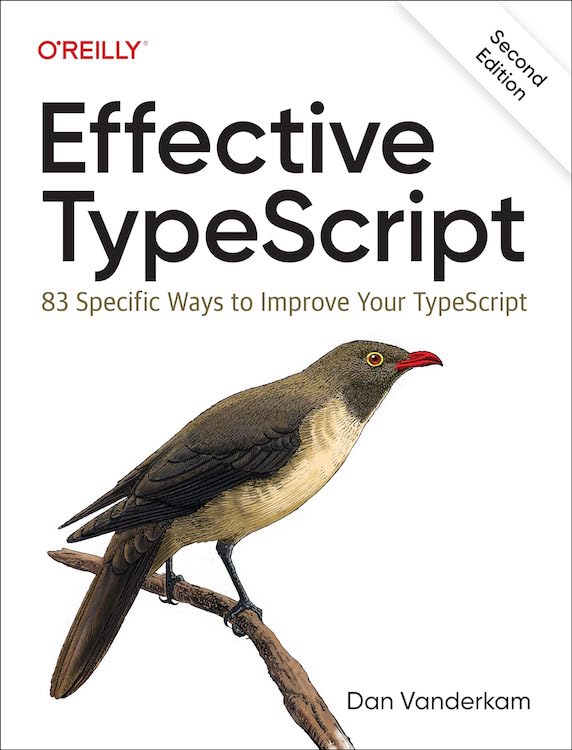This is a sample item from Chapter 4 of the second edition of Effective TypeScript, which was released in May of 2024. It discusses a common mistake in TypeScript code: using "", 0, or -1 to represent special cases like missing data. By modeling these cases with a distinct type, you help TypeScript guide you towards writing more correct code. If you like what you read, consider buying a copy of the book!
JavaScript's string split method is a handy way to break a string around a delimiter:
> 'abcde'.split('c')
[ 'ab', 'de' ]
Let's write something like split, but for arrays. Here's an attempt:
|
This works as you'd expect:
> splitAround([1, 2, 3, 4, 5], 3) [ [ 1, 2 ], [ 4, 5 ] ]
If you try to splitAround an element that's not in the list, however, it does something quite unexpected:
> splitAround([1, 2, 3, 4, 5], 6) [ [ 1, 2, 3, 4 ], [ 1, 2, 3, 4, 5 ] ]
While it's not entirely clear what the function should do in this case, it's definitely not that! How did such simple code result in such strange behavior?
The root issue is that indexOf returns -1 if it can't find the element in the array. This is a special value: it indicates a failure rather than success. But -1 is just an ordinary number. You can pass it to the Array slice method and you can do arithmetic on it. When you pass a negative number to slice, it interprets it as counting back from the end of the array. And when you add 1 to -1, you get 0. So this evaluates as:
|
The first slice returns all but the last element of the array, and the second slice returns a complete copy of the array.
This behavior is a bug. Moreover, it's unfortunate that TypeScript wasn't able to help us find this problem. The root issue was that indexOf returned -1 when it couldn't find the element, rather than, say null. Why is that?
Without hopping in a time machine and visiting the Netscape offices in 1995, it's hard to know the answer for sure. But we can speculate! JavaScript was heavily influenced by Java, and its indexOf has this same behavior. In Java (and C), a function can't return a primitive or null. Only objects (or pointers) are nullable. So this behavior may derive from a technical limitation in Java that JavaScript does not share.
In JavaScript (and TypeScript), there's no problem having a function return a number or null. So we can wrap indexOf:
|
If we plug that into our original definition of splitAround, we immediately get two type errors:
|
This is exactly what we want! There are always two cases to consider with indexOf. With the built-in version, TypeScript can't distinguish them, but with the wrapped version, it can. And it sees here that we've only considered the case where the array contained the value.
The solution is to handle the other case explicitly:
|
Whether this is the right behavior is debatable, but at least TypeScript has forced us to have that debate!
The root problem with the first implementation was that indexOf had two distinct cases, but the return value in the special case (-1) had the same type as the return value in the regular case (number). This meant that from TypeScript's perspective there was just a single case, and it wasn't able to detect that we didn't check for -1.
This situation comes up frequently when you're designing types. Perhaps you have a type for describing merchandise:
|
Then you realize that some products have an unknown price. Making this field optional or changing it to number|null might require a migration and lots of code changes, so instead you introduce a special value:
|
You ship it to production. A week later your boss is irate and wants to know why you've been crediting money to customer cards. Your team works to roll back the change and you're tasked with writing the postmortem. In retrospect, it would have been much easier to deal with those type errors!
Choosing in-domain special values like -1, 0, or "" is similar in spirit to turning off strictNullChecks. When strictNullChecks is off, you can assign null or undefined to any type:
|
This lets a huge class of bugs slip through the type checker because TypeScript doesn't distinguish between number and number|null. null is a valid value in all types. When you enable strictNullChecks, TypeScript does distinguish between these types and it's able to detect a whole host of new problems. When you choose an in-domain special value like -1, you're effectively carving out a non-strict niche in your types. Expedient, yes, but ultimately not the best choice.
null and undefined may not always be the right way to represent special cases since their exact meaning may be context dependent. If you're modeling the state of a network request, for example, it would be a bad idea to use null to mean an error state and undefined to mean a pending state. Better to use a tagged union to represent these special states more explicitly.
Things to Remember
- Avoid special values that are assignable to regular values in a type. They will reduce TypeScript's ability to find bugs in your code.
- Prefer
nullorundefinedas a special value instead of0,-1, or"". - Consider using a tagged union rather than
nullorundefinedif the meaning of those values isn't clear.
